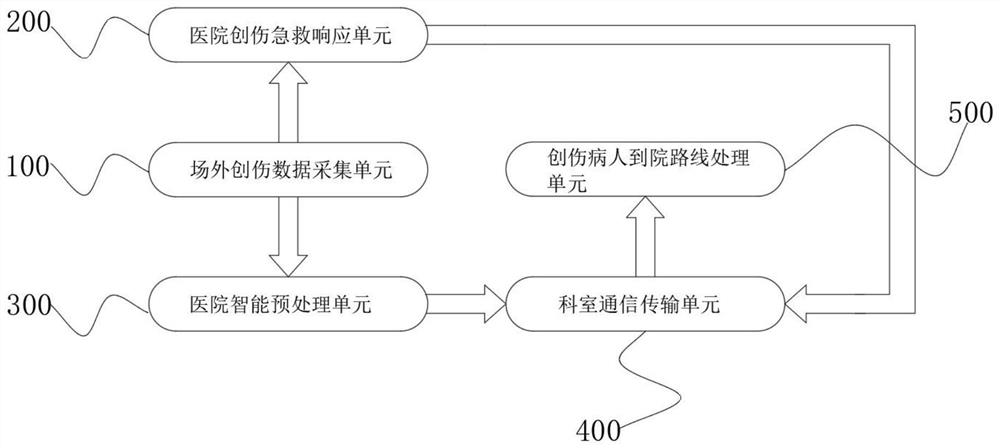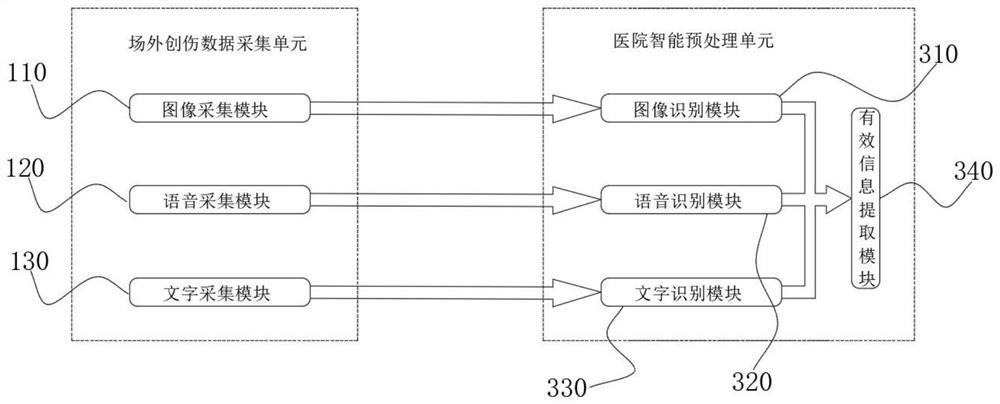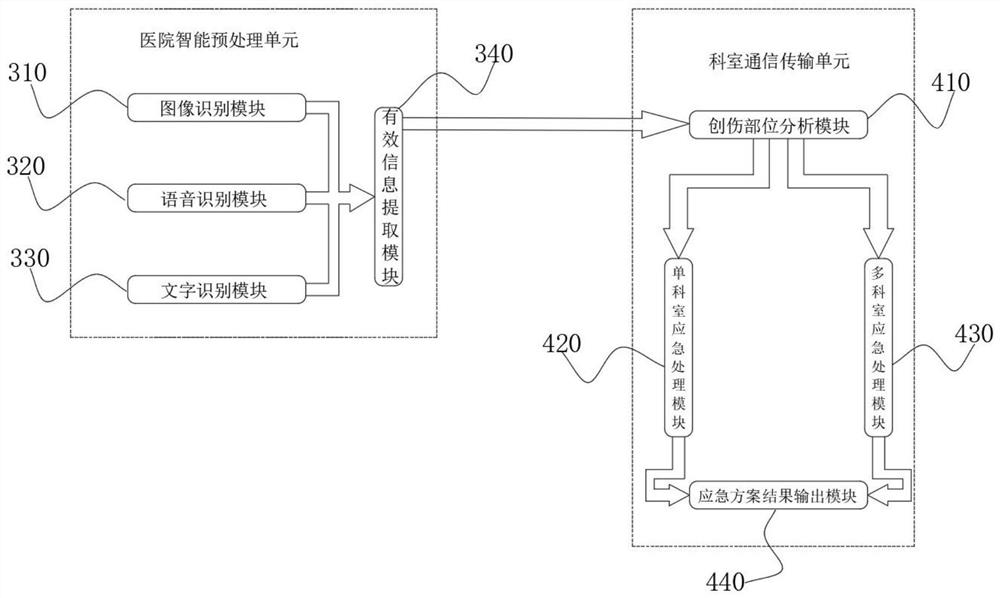Trauma information system based on artificial intelligence, big data and algorithm
An artificial intelligence and information system technology, applied in the field of trauma information systems, can solve the problems of patients missing rescue time, unable to specify treatment plans in time, and unable to provide emergency plans in time, so as to reduce the effect of misdiagnosis.
- Summary
- Abstract
- Description
- Claims
- Application Information
AI Technical Summary
Problems solved by technology
Method used
Image
Examples
Embodiment 1
[0059] see Figure 1-Figure 4 As shown, the purpose of this embodiment is to provide a trauma information system based on artificial intelligence, big data and algorithms, including an off-site trauma data collection unit 100, a hospital trauma emergency response unit 200, a hospital intelligent preprocessing unit 300, and department communication transmission Unit 400, trauma patient to hospital route processing unit 500, wherein:
[0060] The off-site trauma data collection unit 100 is used to collect the scene information transmitted in real time at the accident scene, and send the scene information to the hospital trauma emergency response unit 200; the hospital trauma emergency response unit 200 is used to receive the scene information collected by the off-site trauma data collection unit 100 information, immediately make a dispatch task after receiving it; the off-site trauma data acquisition unit 100 also transmits the received field information to the hospital intellig...
Embodiment 2
[0088] see Figure 5-Figure 8 As shown, in order to further subdivide the consultation of its departments, the specific implementation plan is as follows:
[0089] a. When the trauma site is a single site:
[0090] When the injured part is the head, it is represented by A. In this case, a separate consultation is required from Department 1;
[0091] When the injured part is the upper body, it is indicated by B, and a separate consultation with Department 2 is required at this time;
[0092] When the injured part is the head, it is represented by C. In this case, separate consultation with Department 3 is required;
[0093] When the injured part is the head, it is indicated by D, and a separate consultation with Department 4 is required at this time.
[0094] b. When the trauma site is multi-site:
[0095] b1. Two parts are injured:
[0096] When the injured parts are A and B, at this time, Department 1 and Department 2 need to consult jointly;
[0097] When the injured p...
Embodiment 3
[0110] see Figure 9 As shown, in order to ensure that the patient's wound site accurately corresponds to the department's consultation, the specific process framework is as follows: Enter the patient's wound information, for example:
[0111] When the patient's wound is A, first judge it, the system judges it as a wound at A, and output department 1, and the other outputs are no, the process ends, and department 1 needs to consult with him alone;
[0112] When the patient's wound is B and C, first judge it, the system judges it is not A, continue to judge whether it is B, judge it as B, output department 2, continue to judge whether it is C, judge it as C, output department 3, continue to judge If it is D, the system judges that it is not D, and the process is over. At this time, Department 2 and Department 3 need to conduct a joint consultation;
[0113] When the patient's wound is A, B and C, first judge it, the system judges that the wound is A, outputs Department 1, cont...
PUM
 Login to View More
Login to View More Abstract
Description
Claims
Application Information
 Login to View More
Login to View More - R&D
- Intellectual Property
- Life Sciences
- Materials
- Tech Scout
- Unparalleled Data Quality
- Higher Quality Content
- 60% Fewer Hallucinations
Browse by: Latest US Patents, China's latest patents, Technical Efficacy Thesaurus, Application Domain, Technology Topic, Popular Technical Reports.
© 2025 PatSnap. All rights reserved.Legal|Privacy policy|Modern Slavery Act Transparency Statement|Sitemap|About US| Contact US: help@patsnap.com



